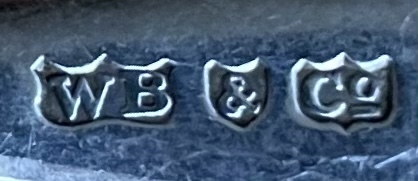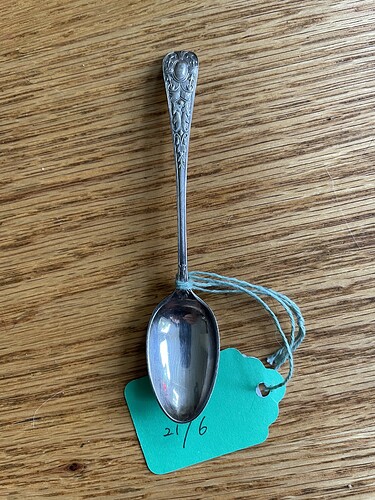Hello, new here.
Might anyone be able to advise on this set of marks on a set of 6 teaspoons?

WB & Co is William Briggs & Co, a Sheffield company. Your spoons may be electroplated or they may be an alloy such as nickel silver. Note that this is a white metal alloy of copper, nickel and zinc and contains no silver.
Phil
Thanks Phil. Appreciate your help.
Any way of discovering when they were made, or how to discern whether they’re ESPN or nickel-silver?
Also I haven’t been able to find a match to their pattern.
The company was active 1875-1922. your spoons probably date to the 20th century part of their history. Try polishing with a good quality (non-abrasive) silver polish. If it comes up as shiny as solid silver would the it’s most likely electroplated. You could also try the acid test on the surface but that is likely to mark it permanently.
We don’t go much for pattern names here in the UK and, with a lot of manufacturers all producing their own patterns in relatively small quantities, finding a match is likely to be nigh on impossible.
Thanks again Phil, very helpful and informative.
Might you be able to suggest any non-abrasive polishing products by their brand names? Or is there a ‘household recipe’ that does a reasonable (and non-destructive) job to start with?
Goddard’s is the one that springs to mind first. Avoid household recipes like the plague and also any product which requires dipping into a soultion.
Excellent.
Thanks again.
“A thin layer of dark tarnish can quickly destroy the surface lustre of silver. This layer consists mainly of black silver sulphide, and is caused by sulphur containing compounds such as hydrogen sulphide in the air. Tarnish can be removed from silver mechanically with a polish, chemically with a dip, or electrochemically. This note describes these three methods for removing tarnish from silver, and explains how to store and display silver objects.”
I find step one with any metal object is to decide if I want to restore it to its look when it was made, sometimes several hundred years ago, or simply remove anything on it which is a foreign substance and which may and probably will further deteriorate the metal.
Either way the first step is to remove dirt and grease. A simple washing liquid in hot water in the sink will soften the caked dirt and remove the grease. Sometimes a soft brush — an old toothbrush. — gets stuff out of cracks and indents including the hallmarks themselves. If there are ivory insulators on handles keep them dry and out of the soap as it will yellow them. Ditto baleen handles on toddy ladies
After this is done, I take a cloth impregnated with jewellers paste or other cleaner by Goddard or Haggerty and giver it a quick rub. Often that is more than enough.
Two things this doesn’t help with is black spots andtannin stained teapot interiors. Both best left to the professionals and both involve chemicals or abrasives or both.
Word of warning on those old tannin-coated teapots: some of them are very thin metal and the only thing stopping them leaking is the tannin itself. Embossing on thin plate or soft solder repairs to rims are both danger spots.
Oh, and those chemical dips: dangerous to you and lethal to silver. If you are using them wear gloves as it contains acidified thiourea which is a carcinogenic and wash it off immediately and thoroughly after a quick dip. Also wear a mask as if fumes gets in your lungs it causes permanent damage. You will have to use a polish cloth after dipping to restore the surface.
A word about patina: if you want to keep it, don’t buff silver and don’t immerse it in chemical dips.
Patina which can only come with age and use (and sometimes misuse). Some call it a butler’s polish. It is sometimes faked by modern factories — this is a process similar to niello; a black metallic alloy made by fusing together silver, copper, and lead and then mixing the molten alloy with sulfur. Siamese silversmiths put hundred of years and thousands of bahts on silver they sold to R&R troops through the decades.
We know what dips do. Buffing literally physically reorganizes the surface molecular structure of silver so that scratches get filled it. It results in a mirror-like finish — again exactly the way it may have arrived directly from the factory. — I regard marks on silver rather the same way as lines on my face – earned and not only an enhancement but history. The only item I ever buffed was a very heavy — 13 troy oz, early 20th century plain soup ladle which someone had been using as a mallet.
Oh and kind of obvious but don’t buff vermiel. In fact if you are lucky enough to have a pre-1810 salt pot or chalice with that soft fire-gold gilt, don’t do anything to it. Don’t even rub it. Some silversmiths, using the lost mercury system of applying gilt gave his life to you could enjoy it. Literally. Like Solomon Hougham’s brother Charles who died from breathing in mercury vapors. By 1820 the mercury lost system was replaced by electro-plating, although I have seen bits made in the 20th century still using the mercury loss system, presumably with large vent fans and masks for the workers. If the old gilt is patchy resist the temptation to re-gilt it using modern methods. It is akin to electroplating old Sheffield plate where the copper shows through or is exposed on one side. It’s vandalism. The Late Ian Carmichael, an otherwise excellent Victoria BC silversmith, and I disagreed about this as he applied thin coats of .999 silver to old Sheffield to the delight of his many faithful customers and over my objections.
CRWW
Erratum: “…toddy ladles”. not ladies. Apparently my eyes can not longer see i’s in this font size.
CRWW
Fascinating and very helpful, thankyou!
You are very kind. It was a massive over response to a fairly simple question which Phil had more than adequately covered.
There are two reasons why the next generation is leary of silver; first they are not sure if it is, or if it is plated or electro-plated or even white metal, and secondly they wrongly think it is a pain in the proverbial to clean.
The first problem can only be cured by reading about and buying small bits and generally learning a little about it as you are doing on this excellent site.
The second, cleaning it is even easier to solve. Don’t live in parts of the world where the air is full of hydrogen sulphide. ---- towns with cars, near factories or anywhere in China. ---- and if you do, or in any event, keep the air away from your silver and make sure that the air that does get near it is dry ---- those things they stuff in patent pill bottles work well. Just throw a couple in the drawer.
Never store silver in or near cooking stoves for obvious reasons. Modern kitchens are notorious for designing kitchens with cupboards proximate to cooking stoves. The natural gas ones are particularly lethal and the fumes they give off blacken silver in a week or less. Methane is one of the delightful components.
Don’t wrap silver in plastic foil as that off- gases worse than the air it is supposed to protect the silver from. Don’t coat with varnish as that yellows and chips off. If you have a diligent butler or man servant who thinks your staff should spend each Friday pm cleaning silver in his pantry, get rid of him and hire a lazy one. Your silver will last far longer with less abrasion from frantic junior staff.
Don’t buy or use egg spoons and don’t eat duck or chicken as they both contain sulphides in the flesh you stick your fork into. It’s the stuff they are raised on. If you want to eat duck go out and shoot one in the wild. They won’t stain the fork nearly as badly. These days hand reared pheasants are equally bad for the silver. If get invited to a days shooting make sure the brace you are offered at the end of the day for your 1,750 pound fee have been chomping down on grain grown by the local farmers and not something the keepers stick in feedpens.
Don’t use those wonderful 18th century salt cauldrons the Hennells so over supplied us with or if you do, empty them and wash them out and dry them after each meal. Do not ever buy modern shakers. They are just a tarnish away from driving you insane with the cleaning problem they present and were invented by 19th and 20th century silversmiths who wanted you to have to replace them annually as they rotted away.
When you are next attacked, invaded or under siege, try and resist the temptation to bury your silver. Gold is fine, silver, unless you manage to get it into a dry clay is not going to like going back into the ground.
Don’t buy your wives or girl friends silver as a token of your affection. It is going to react badly if they sweat and almost all of them do. In the old days — actually right up until WWI before antibiotics made it possible to have longer and more deadly wars using the same troops over and over again, silver was used extensively for medical appliances and as an anti- bacterial measure.
My great grandfather came out of WWI with a silver plate in what was left of his head. He used to joke that he had taken the King’s Shilling to join up and got another when he left. He also claimed he could get “the wireless”
certain times of the day.
Silver is a very good conductor – there is a lot of it in your car and computer as solder for wires – so he might have been onto something.
THose wooden boxes silversmith manufacture to keep sets of silver in, don’t buy them. Wood off gases. If you have an old one its not as bad as the new ones, but should be avoided. Ditto silver cupboards made of wood or really anything that isn’t inert. Silver stored in steel bank vaults away from zealous butlers and wood last well.
There is another way of keeping silver clean: use it daily. I have a pair of John Swift beer mugs made in the mid 1750’s and one one for a pint with lunch and another for a pint with dinner. I haven’t cleaned them, other than a rinse after the meals, for decades.
Not only does beer taste better out of them – there is some dispute on this in the family- but if anybody over- anxious to inherit them slipped anything untoward into the beer, the silver would react badly, thus saving probate fees on them for a while longer.
Haha, a very entertaining journey to becoming better informed. Thanks again.
